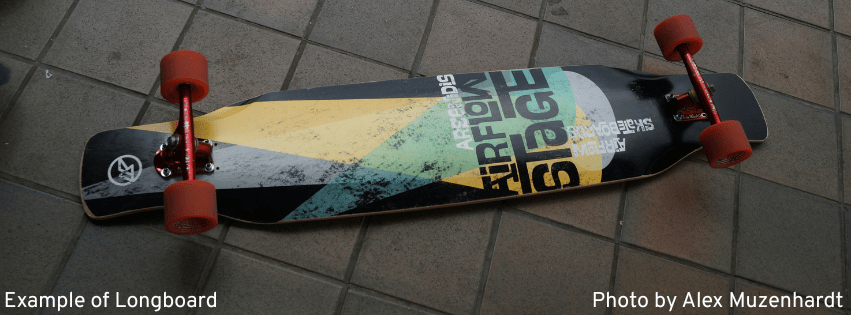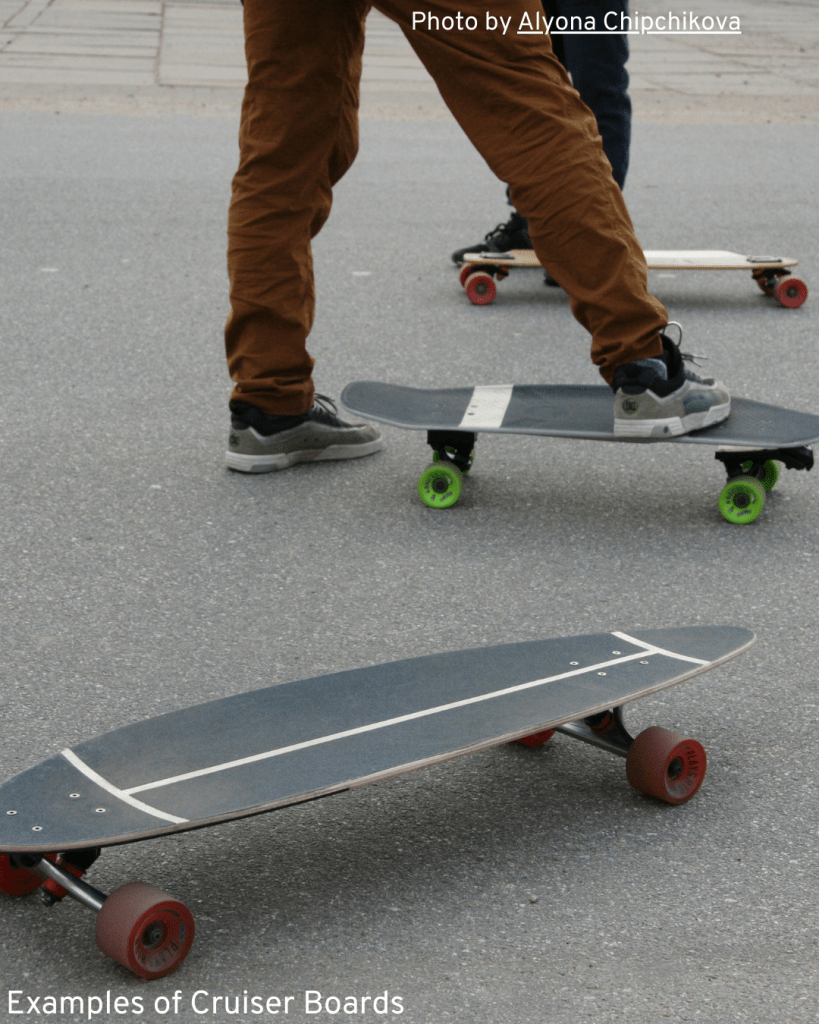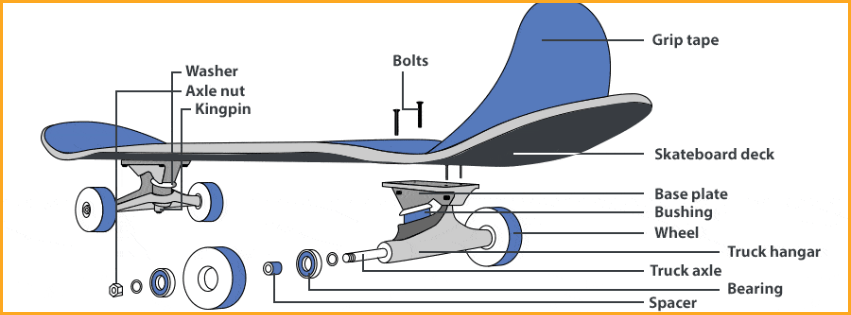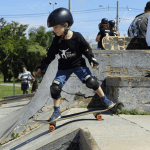Skateboarding For Your Child, What To Choose?
Table of Contents
Key Highlights
- Safety first: Skateboarding for children should be prioritized with safety concerns so always use a helmet and pads.
- Start with the basics: Skateboarding for beginners should go with the option of a complete skateboard, as it comes fully assembled and ready to ride.
- Skateboard Size matters: Choose a deck width that suits your child’s age, shoe size, and riding style.
- Different boards, different purposes: Longboards are ideal for cruising, while standard boards are best for tricks and skate parks.
- Focus on quality components: Invest in a skateboard with durable trucks, smooth-rolling wheels, and high-quality bearings for the best performance.
Skateboarding for children is exciting and getting your child their first skateboard is a memorable moment. With so many choices, it can feel a bit too much. This guide will help you make it easy. We will give you the information you need to pick the right skateboard for your child. You will learn about the different types of skateboards and what they are for. We will also talk about the board deck size, shape, and parts. Whether your child is just starting to get into skate or is ready to skate at the park, we are here to help!
Understanding Skateboard Types and Their Purposes
Standard skateboards, longboards, and cruisers each serve distinct purposes in the world of skateboarding for Children. Standard skateboards are versatile, ideal for tricks and street skateboarding. Longboards, known for their stability, are perfect for cruising and transportation. On the other hand, cruisers are more compact, making them great for commuting short distances. For beginners, a standard board is recommended due to its all-around capabilities. Understanding the intended use of each type ensures that skaters, whether beginners or seasoned riders, can select the most suitable option for their needs.
Standard skateboards are what most people think of when they imagine a skateboard. They have a curved, rectangular skateboard deck. These boards are made for doing tricks, riding at skate parks, and handling obstacles. Their small size makes it easy to turn and move quickly. This is perfect for people who want to learn moves like ollies or kickflips.
Longboards are different from standard boards, like plastic “penny” boards. They have a longer board deck. This design gives more stability and makes riding smoother. Longboards are great for cruising, carving, and going longer distances. They are a good choice for beginners who want a relaxing ride across different terrains.

Cruisers focus on comfort and smooth riding. They have a shorter and wider board deck than longboards. They also have softer wheels. This mix of features makes cruisers easy to steer and stable. They are great for riding on sidewalks, bike paths, and uneven ground without trouble.

Which Type is Suitable for Beginners?
For beginners who are starting their skateboarding journey, stability and control are very important. Longboards and cruisers are two good options, each with its own benefits based on the type of ride you want.
Longboards have a longer board deck and larger wheels. This gives them great stability, which helps beginners keep their balance and build confidence. They’re perfect for relaxing rides and carving. This allows new riders to learn the basics of balance and board control.
Cruisers are smaller and very easy to handle. They work well for riding on sidewalks and short distances. Their larger wheels and stable design provide a smooth, controlled ride. This makes them good for city riding and getting over small bumps. Their quick response lets riders make sharp turns easily, providing a sense of success skateboarding for the first few days.
Choosing the Right Skateboard Size and Shape
Now that you know about the different types of boards, let’s talk about why it’s important to choose the right skateboard size and shape of a skateboard deck. This choice helps new skateboarders have a more comfortable and controlled experience.
When a board deck is the right size and shape, it not only keeps your child safe but also helps them learn and enjoy skateboarding even more!
Importance of Width and Length
When picking a board for your child, pay more attention to the board deck width than to its length. A wider board gives them more space for their feet and helps with stability. This is very important for beginners who are learning to balance. Usually, kids under five should have a board deck that is 6.75 inches (17 cm) wide or smaller.
For children aged six to eight, a 7-inch (18 cm) wide board deck is often comfortable for old school tricks. As they get taller and their shoe size grows, you might want to switch them to a 7.5-inch (19 cm) wide deck or larger, especially if they are older than 13.
Keep in mind, these are general tips. The best way to find the right board deck width for your child is to visit a skate shop. Let them stand on different boards. They should place their feet slightly wider than shoulder-width apart and check if they feel comfortable. Pick a width that lets their feet be spaced out comfortably on the deck without feeling cramped or unstable.
How Shape Affects Performance
The shape of a skateboard deck, called the concave, can greatly affect how well it performs and how your child rides. Concave means the slight curves and dips that run along the skateboard deck. Most normal skateboards have a concave shape that helps the rider have better control.
For beginners, a mild or mellow concave is a good choice. It makes the skateboard more stable and forgiving. This helps with balance and makes learning basic tricks easier. As riders get better and want to try more advanced flip tricks, they usually switch to decks with a steeper concave.
The shape and depth of the concave can change how responsive the skateboard is and how it turns. Beginners should stick to a mellow concave, while those with more experience might want a steeper concave to gain more control during tricks. If your child is unsure what to choose, it’s a good idea to ask seasoned skaters or visit a local skate shop for advice.
Specific Components and Their Functions

Now that you know how to choose the type, size, and shape of the skateboard deck, let’s look at the parts that connect everything: the trucks, wheels, and bearings. Think of these as the engine and wheels of your skateboard. Each part is important for how well the skateboard performs and how enjoyable it is to ride.
Knowing about these parts and what they do helps you make good choices when picking a skateboard. This way, you can make sure your child has a smooth, safe, and exciting ride.
Components of a Skateboard
A skateboard has several important parts that work together to give riders a good experience. The deck is the flat wooden board where you stand. Underneath the deck are the skateboard trucks, metal axles that connect the wheels to the deck and help you turn and steer.
The wheels are often made of polyurethane, and they decide how smooth and fast your ride is. Inside the wheels are the bearings, which help them spin easily around the axle.
Deck Materials and Durability
The skateboard deck is the wooden platform you stand on. It is usually made by gluing together layers of maple wood. Most decks have between seven and nine layers, which affects their strength, flexibility, and how long they last.
Choosing a deck made from high-quality maple wood gives you the best durability and performance. Famous brands carefully check their decks to use strong glue and good pressing methods. This helps the decks handle the challenges of skateboarding.
A well-constructed skateboard deck lasts a long time. It can take the hard hits from jumps, the pressure from tricks, and regular wear from use. When picking a board, it is important to focus on quality materials. This choice affects how long the board lasts and your child’s overall skateboarding fun.
Wheels and Bearings
Skateboard wheels come in different sizes and hardness. These factors affect how fast you can go, how much grip you have, and the overall riding experience. For beginners, using smaller wheels (50-53mm) helps with stability and control. This makes them great for street skating and skate parks. On the other hand, larger wheels (60mm and up) and large wheels can go faster and are better for cruising on rough surfaces.
- Wheel Hardness (Durometer): This is measured on the A scale. Higher numbers mean harder wheels. Softer wheels give you better grip, while harder wheels let you go faster on smooth surfaces. Beginners usually like a durometer of 92A to 99A.
- Skateboard Bearings: These small metal rings help the wheels spin easily. Even though they are often ignored, good skateboard bearings can boost your speed and make your ride smoother. Aim for bearings with an ABEC rating of 5 or higher for the best performance.
Getting good wheels and skateboard bearings can greatly improve how smooth and fast the ride is. They might feel like minor parts, but they are very important for your child’s skateboarding experience.
Looking closer at each important part of a skateboard helps you understand how they are made and how they work. This knowledge will help you choose the right pieces for your child’s needs.
From the material of the deck to the details of the truck shapes, knowing how these parts function gives you the ability to build a skateboard that matches your child’s skating style. This way, your child can have the best and most fun experience while riding on the board.
Optional components
While the essential components of a skateboard encompass the deck, trucks, wheels, and bearings, incorporating optional parts can enhance the experience and cater to specific stylistic preferences. Risers, for instance, are plastic or rubber pads installed between the skateboard deck and trucks, elevate the board’s height, provide additional clearance for the wheels, and affect turning.
Skateboarders often utilize riser pads to mitigate wheel bite, especially when using larger wheels, or to fine-tune their turning preference. For more experienced riders or those interested in customizing their setup, exploring these optional components can add a personal touch to the skateboard and cater to specific preferences:
| Component | Description |
| Riser Pads | Placed between the deck and trucks to prevent wheel bite and adjust truck height. |
| Grip Tape | Provides traction for your feet on the deck. |
| Hardware | Bolts and nuts used to assemble the skateboard. |
| Skateboard tool | An all-in-one tool for assembling and adjusting your skateboard |
Maintenance and Care
Proper maintenance is very important to help your child’s skateboard last longer and work better. Check the board often for signs of damage like cracks in the deck, loose trucks, or worn wheels. Tighten any loose nuts and bolts. Replace parts that are worn out right away.
Make sure to keep the bearings clean and greased. This helps them roll smoothly and keeps them from wearing out too soon. Encourage your child to clean their skateboard often. They should remove dirt and debris from the deck, wheels, and trucks. Simple care can help keep the skateboard in good shape and make riding it safe and fun.
Conclusion
Choosing the right skateboard for your child is very important for their safety and fun. It’s good to understand the types, sizes, and parts of skateboards to make the best choice. Think about things like their skill level, riding style, and age when picking the right board. Taking care of the skateboard will help it last longer and work well. Don’t forget that safety gear is a must for a safe skateboarding experience. If you are confused about where to begin, ask experienced skateboarders or go to a good skate shop for help. Get ready to see your child ride confidently on their new skateboard!
FAQ
What is the Best Age to Start Skateboarding?

There’s no exact age that is best for starting. It really depends on the child’s interest and if they are physically ready. Many kids start between ages 5 and 10. You should encourage them with good guidance. Always put safety gear first and watch over them, especially at skate parks.
For beginners, being patient is important. First, get comfortable on the skateboard deck. Then, practice balancing and learn how to push off. Make sure to use good safety gear and pick a proper skateboard. It’s okay to take your time. Think about taking lessons or practicing at skate parks with skaters who have experience.What safety gear is essential when skateboarding?
Wearing safety gear is a must when skateboarding. A helmet is important to keep your head safe. Wrist guards, elbow pads, and knee pads can help stop breaks and cuts if you fall. Even skaters who have a lot of experience should focus on safety, especially in tough places like skate parks.
